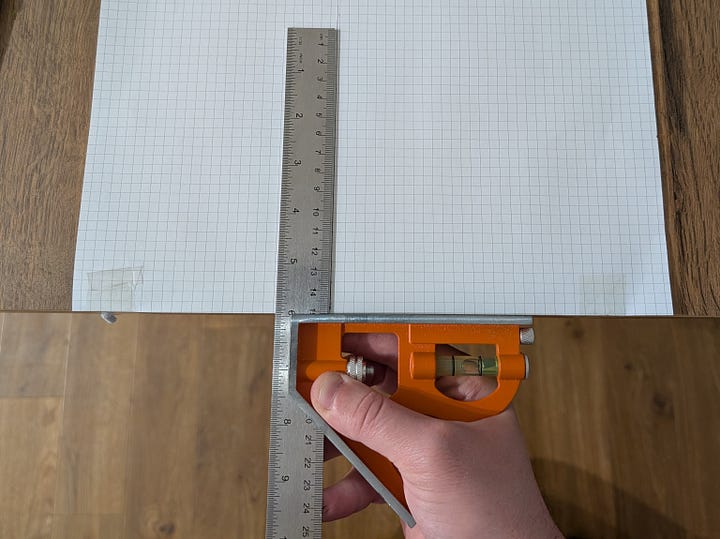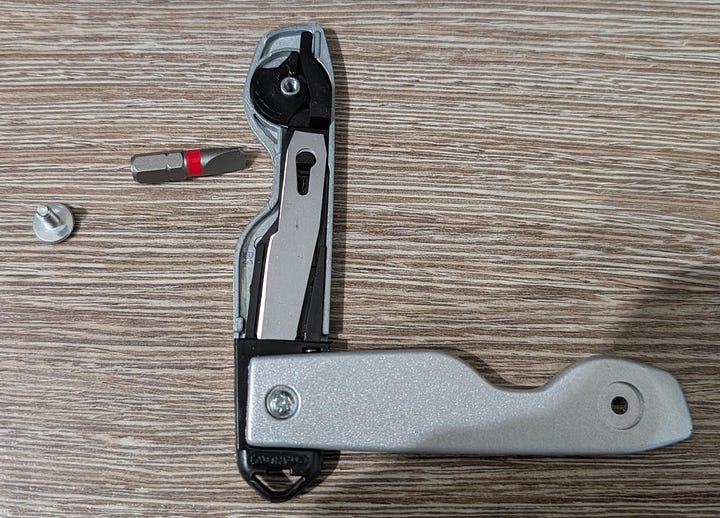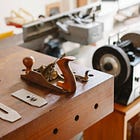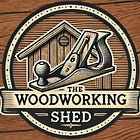The Tools I Can't Live Without: Marking & Measuring
Another episode in The Woodworking Shed Toolbox series. This episode demonstrates what I consider to be the essential woodworkers Marking & measuring tools!
New to The Woodworking Shed? Don't worry! I've this handy index page to find every episode in this series and more!
Here’s a link to the previous episode!
Marking & Measuring Essentials
Welcome back to The Woodworking Shed! This week I'm diving into the essential woodworking marking and measuring tools!
There are many tools that can be used for marking and measuring in woodworking. I’m trying to build up the essentials before trying out any single-use or gimmicky solutions!
But first, I need to understand what the essentials are!
If you want to know more about my essential woodworking toolkit, check out this episode, which covers the whole toolkit!
What Makes a Tool Truly Essential?
For a tool to earn a spot in my essential toolkit, it needs to be more than just convenient - It needs to be something I'll use regularly and struggle to do without.
I believe that by tackling things the hard way before relying on specialised tools will help me to learn and better understand the fundamentals.
Ultimately, this should make me a better woodworker… Jury’s still out on that one…
You learn to walk before you can run!
There are so many marking and measuring gadgets out there designed for woodworkers.
Many of them are designed to make certain tasks easier rather than serve a core function. It's easy to get lured into the trap, next thing you know your workshop is full of “useful” gadgets you never use!
I'd like to avoid this!
I think the best example I can give of non-essential is the dovetail jig. They’re a great little tool for laying out dovetail joints. But it isn’t essential.

You can do the exact same thing with a sliding bevel. A tool that can be used for more than just setting up dovetails!
Of course the dovetail gauge makes the process quicker - That’s the whole point of it!
But it is a single-purpose item. This is what I’m trying to avoid in my essentials list.
When I have a more established toolkit and more experience, I will branch into more specialised marking and measuring tools.
I’m almost certain that one of them will be a dovetail gauge…
Let's dive into the essentials!
The Tape Measure
I don’t have much to say about tape measures, they're good for measuring long things.
What is important is that the tape measure you buy is accurate and clear to read.
I am currently using the Stanley Tylon tape measure. It's something I already have so I'm going to stick with that for a while.
As I've already got one I haven't done too much research into “woodworking" tape measures. However, I have seen Fastcap recommended a few times for its accuracy and ease of use.
It has a flat tape which I can see being a big benefit. I'll probably try one at some point.
And hey, if it's no good. It's still useful as a pencil sharpener!
Moving on…
The Combination Square
When you look at any kind of woodworking content online. There is ALWAYS a combination square to be seen somewhere. It might be one of the most used tools.
For good reason too!
It’s perfect for scribing across pieces. Checking for 90 degrees square or 45 degrees, and it's even a ruler!
I've bought myself a 12" Bahco combination square, it was a no brainer for me.
It's a Swedish company with a long history of producing quality tools.
I bought the 12" version to cover all bases. However, I do regret that. It's clunky. Perfect for wider boards, but I feel like I have to work harder with it on thinner material…
I'm going to get the 6” version of the same combination square to make a set.
Regardless of brand it's important to check that your square is actually square, else it will have you pulling you hair out wondering why everything is on a slant!
It's really easy to do, here's how I checked mine:
Set up a piece of paper along a known square edge. I've used my dining table. I taped the paper to the table to make sure it doesn't move around.


Simply level up with the square edge and draw alone along the rule. Then flip the square and do the same along the same line.
If they match up. You're square! Easy stuff.
As you can see I'm all square with mine. As expected from a Bahco!
The Sliding Bevel
This is a very versatile tool with many uses. Its main function is for transferring angles without measuring them, which can be done in various ways:
Capturing the angle between two existing pieces.
Transferring an angle from a drawing to a workpiece.
Transferring an angle from a workpiece to a drawing.
Marking out dovetails when used with a protractor.
What other uses have you found for a sliding bevel have? Let me know in the comments…
Here’s a fun fact: I actually built one of these once. Back in college, many moons ago, it was one of my assessment pieces for my hand tool metalwork module. I didn't know what it was used for at the time!
I have no idea what happened to it…
I've bought a budget sliding bevel that’s made by Silverline. I couldn’t see why I would need to spend more on a “premium” version at the time.
To be honest, it’s pretty good quality for the money. I can only think of two things that I would change:
I wish it were a bit smaller…
The locknut is too wide!
The size can’t be attributed to this tool, that is on me for not buying a smaller one.
The lock nut, on the other hand, hangs over the edge of the top of the handle, which causes issues. When rotating the nut to lock the angle it lifts the handle up.
I’ll either replace the nut or file this one down at some point.
Steel Rule
Everyone's used one of these, and everyone knows what they are for...
Perhaps you've used a plastic or a wooden version, they’re all the same - Bar accuracy.
I did think for a while that I could get away without buying a steel rule. For the simple reason that the combination square has one built in.
I figured I could just pull it out when needed.
This absolutely works…
…But it's awkward as hell to put it back in!
Total waste of time. I did this a few times recently when measuring offsets for my shed doors. I soon realised that just buying a rule will save me loads of time.
I've ended up buying one from the Japanese brand Shinwa. They stood out to me because they have a little kickup at the end to make them easy to pick up.


If you’ve ever tried to pick a steel rule up off a flat table you’ll understand why that's a good feature!
The Pencil
The Pencil has been a part of the Craftsman's toolkit for…
… Yeah, I'm not going to write about pencils.
Just get one.
If you do want to know more about pencils,
has written a useful post on marking tools:The Marking Knife
Why bother with a marking knife when I have a pencil?
Marking with a knife cuts the wood fibers which prevents tear out. Tear out is where the wood fibers get ripped or torn out rather than cut. It often happens when sawing - as I've recently learned…
There are loads of marking knives out there, a lot of them are “special woodworker’s marking knives” and you will pay a premium for them.
There may be some advantages to using a bespoke woodworking knife but any thin blade will do. You could even use a scalpel!


I got this knife because it’s the one that Paul Sellers uses, it’s just a pocket knife, it isn’t designed for woodworking - But it works, and for £10 it’s much cheaper than most woodworking marking knives.
It’s a compact design with internal storage for two spare blades. The blades can be sharpened but for the cost of them, I don’t think it’s worth the effort!
My only gripe after trying it out is that the screw that holds it together comes loose too easily. It folded the wrong way on me once whilst trying to do a knife wall.
Thankfully, the back of the blade is blunt!
Marking Gauge
The marking gauge is a woodworking tool used to scribe lines parallel to an edge.
It's essential when marking out joints such as mortises.
As someone who is looking forward to breaking out the chisels and chopping some traditional joints - A marking gauge is definitely essential!
If you're new to woodworking this might be the one essential tool you've never seen before.
It's made up of two parts, the fence and the beam. The beam (the long part) has blade or pin in it which is used for scribing.
I'm lucky enough to have been gifted a marking gauge! It's a gift from Paul, my guest poster for those awesome DIY bench planes.
It's come all the way from Salem, MA, so I hope it isn't cursed…
Can't wait to put it to the test!
The essential list
So there we have it! My list of essential beginner woodworking marking & measuring tools:
Tape Measure
Engineers square
Steel Rule
Bevel gauge
Marking knife
Marking Gauge
Pencil
Have I missed anything that you consider to be essential? Let me know in the comments…
Enjoy this episode? Why not share it?
I want to build The Woodworking Shed into a strong, engaging community. So if you know someone else who may enjoy it too: Don’t let them miss out - Share it!
New to The Shed? Pull up a chair…
Subscribe now to stay updated on my shed transformation, tool discoveries, and woodworking projects. Don’t miss out!
Support the Shed!
You can support The Woodworking Shed by becoming a paid subscriber or by buying me a coffee for a one-time boost. Your contribution helps me to keep delivering great content and justify all these tools!
Got something to say? Join the conversation!
Have a question, a tip, or just want to say hello? Leave a comment below! I love hearing from my readers and building a strong community!
Look forward to hearing from you -
~ The Woodworking Shed
Hungry for more?
Here’s the next episode:
Check out my other content! Head over to the homepage to find it all!













Thanks for the shoutout!
I've written about marking gauges too :-) https://walteregon.substack.com/p/marking-gauges
You ask: "Have I missed anything that you consider to be essential?" Yes, compass (divider) & callipers. A good compass, with two points rather than a lead, is very useful for dividing distances, for 'walking out' divisions. As for callipers, they're the most used measuring tool for bench-work -- you'll need to measure the thickness, width and depth of things accurately, all the time. https://walteregon.substack.com/p/callipers
Great list. As someone who uses relatively few hand tools day to day, I can say that most of these things are still pretty essential in my workflow. My marking gauges recently got relegated to the second tier tools drawer, but other than that, I use most of these daily.
Keep it up!